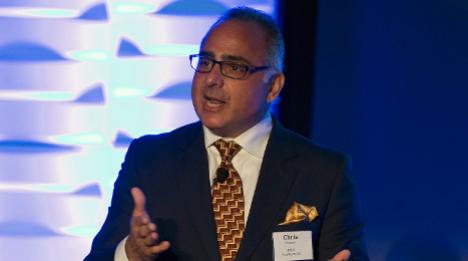Auto loan defaults spiked a bit in October, though analysts say consumer credit default rates still remain at “low levels.”
According to data released Tuesday by S&P Dow Jones Indices and Experian, auto loan default rates came in at 1 percent in October, up 8 basis points on the S&P/Experian Consumer Credit Default Indices. In October 2014, the auto loan default rate was at 1.05 percent and in September of this year, rates came in at 0.92 percent.
The Indices, after being adjusted for October, show an overall default composite rate of 0.94 percent in October, which is up 5 points from September. The first mortgage default rate was up 1 percent and eight basis points last month.
In fact, the bank card default rate was the only rate to decline in October, coming in at 2.75 percent from the month, which is down two basis points.
“Despite recent modest increases, consumer credit default rates remain at low levels,” said David Blitzer, managing director and chairman of the Index Committee at S&P Dow Jones Indices.
“Defaults for bank cards had popped up somewhat in April, but subsequently fell back to the pace seen at the start of this year. At the same time, total bank card, or revolving, credit outstanding as reported by the Federal Reserve has been growing more rapidly in the past few years,” he continued. “The year-over-year growth increased from about 1 percent in 2012 to almost 5 percent in the third quarter of 2015. Non-revolving credit is also expanding at a stable 7.5 percent year-over-year pace in the last three years.”
Blitzer went on to say the indicators of the consumer economy are “mixed.”
“Total vehicle sales were strong with an 18 million unit annual rate in October, while retail sales showed scant growth at 0.1 percent per month in October. One positive item is that the University of Michigan consumer sentiment report came in at 93.1 in November compared to 90.0 in October,” he shared.
Breaking down the default rates by cities, Experian reported three of the five major cities saw their default rates rise last month.
- Miami saw a 1.29 percent default rate, up 22 basis points from September.
- New York’s default rate increased by five basis points to 0.95 percent for the month.
- Dallas reported a 0.75 percent default rate in October, up four basis points.
On the other hand, Chicago and Los Angeles both saw their defaults rate fall by two basis points each, coming in at 1.07 percent and 0.72 percent, respectively.
TransUnion’s Industry Insights Report found that outstanding auto loan balances surpassed $1 trillion in the third quarter, an 11.1 percent jump year-over-year. But contract holders appear to be maintaining their payments on that growing balance total since delinquencies — the rate of borrowers 60 days or more delinquent on their account — continue to remain flat, coming in at 1.16 percent in both Q3 2014 and Q3 2015.
During a phone conversation with SubPrime Auto Finance News, TransUnion senior vice president and automotive business leader Jason Laky said, “We don’t expect any surprises from a delinquency perspective.
“Auto lending and performance is correlated to the strength in the economy, particularly employment,” Laky continued. “As long as employment continues to grow strongly and consumers have confidence in the economy we’ll continue to see growth in auto sales and financing. Consumers who believe they’ll be employed for a considerable time are willing to go forth and take on a loan to pay for a car.”
In the past year, auto loan balances have increased $101 billion to $1.008 trillion in Q3, according to the latest data.
TransUnion reported nearly 75 million consumers have an open auto account, an increase of 5 million since Q3 2014 when the figure stood at 69.5 million. Analysts pegged the number of consumers with access to an auto loan grew 2 million quarter over quarter from 72.5 million in Q2 2015.
TransUnion also shared information for the subprime space.
Auto loan balances for the subprime risk tier — those consumers with a VantageScore 3.0 credit score lower than 601 — remain the smallest segment with 15.3 percent, or $154 billion, of the total balance. However, analysts pointed out this figure is the highest share of auto balance observed for the subprime risk tier since Q1 2011.
Consumers in the prime or better risk tiers —those with a VantageScore 3.0 credit score higher than 661 — represent $670 billion of the $1 trillion in balances.
The average balance across all auto loan accounts was $14,515 in Q3, a 2.7 percent increase year-over-year, and the slowest pace of average balance growth since Q4 2011. The average subprime auto loan balance increased 4.2 percent from $13,328 in Q3 2014 to $13,890 in Q3 2015, the lowest growth rate since early 2012.
“As total auto loan balance rises, we’re seeing controlled and deliberate growth by lenders,” Laky said. “Consumers continue to feel confident in their employment or job prospects, and their appetite for new auto loans reflects this confidence.”
“More consumers have access to auto loans, yet delinquencies remain low as they continue to responsibly manage their payments,” he continued. “Consumers are taking on more and bigger auto loans in today’s low-rate environment, but we see no cause for concern as delinquencies remain steady.”
Viewed one quarter in arrears (to ensure all accounts are reported and included in the data), TransUnion indicated new auto loan originations exceeded 7 million for the first time in Q2. Up 13.5 percent from Q1 and 6.4 percent from Q2 of last year, originations reached 7.3 million this past quarter.
Along with origination growth, the average new auto loan balance grew to $20,016 in Q2 2015. The average balance increased $567 from the average balance in Q2 2014 of $19,449. New subprime auto loan balances increased 3.7 percent year-over-year from $16,781 in Q2 2014 to $17,357 in Q2 2015.
Another element Laky highlighted with SubPrime Auto Finance News is how much younger borrowers are tapping the market.
TransUnion noted consumers age 30 and younger continue to finance vehicles at a healthy pace, with more than 1 million more young adults opening an auto loan or lease in the past year, analysts determined 11.7 million consumers under the age of 30 have an auto loan or lease reported to TransUnion. That figure is up 1 million, or 9.6 percent, from Q3 2014.
“Contrary to some of the messages about consumers buying and financing cars in this new sharing economy, it’s not true,” Laky said. “As younger consumers are getting settled and employed, building their lives and their families, they’re realizing that they need cars to get the things done that they want to do in their lives, and they’re out there taking loans for them.”
So whether the account holders are young or more mature, Laky maintains the health of the auto-finance market is good, even if some conditions deteriorate.
“If the economy begins to turn and employment increases, that’s when auto lenders can begin to worry about an increase in delinquency,” Laky said. “Even then, I wouldn’t expect a dramatic increase in delinquencies.
"Even in the prior recession, we didn’t see a large increase in delinquencies even as other asset classes were having a big jump,” he continued. “The reason is the auto loan remains the priority loan payment in the consumer’s wallet. It’s a question of how important cars are both in utility for getting to and from a job and getting your family to and from places as well as the lifestyle benefit of having a nice car.”
Without necessarily having to be too aggressive with underwriting to consumers lower down the credit spectrum, Ally Financial emphasized that it remains on track to reach its goal for originations this year despite the headwinds of not collecting as much business from direct relationships with General Motors and Chrysler.
The objective of hitting $40 billion worth of paper coming into the portfolio is within reach because Ally originated $11.1 billion in contracts during the third quarter. The performance pushed the company to $31.7 billion through the first nine months of the year.
“We remain on track to surpass our target for the year despite the shifts in the business,” Ally chief executive officer Jeffrey Brown said when the company hosted a conference call with investment analysts after sharing its Q3 financial statement. “The business is well-positioned in the marketplace, increasingly more diversified and poised to provide consistent returns.”
In his opening comments, Brown tried to nip any thinking that Ally would simply hit its targets by taking on more subprime paper.
“Yes, we’ve expanded risk appetite in the more non-prime flows, but we’re still fairly modest at sub-15 percent origination allocation and fully underwrite with the focus on the borrower’s ability and willingness to repay,” Brown said. “And that’s a fact not necessarily true with some of all the deep subprime players.”
Ally insisted that it generated 36 percent increase year-over-year consumer originations, which included $607 million of consumer loans and leases from Mitsubishi Motors Credit of America. Brown pointed out the company collected the highest application volume across all dealer channels in Ally history during Q3. That application flow came from about 17,000 dealers across all 50 states.
“Despite some of the media noise … dealer relationships remain robust, and that was reinforced as I spent several weeks visiting with dealers across the U.S. over the past few months,” Brown said. “We’ve been saying for quite some time this is truly a relationship business and partnering so closely with the dealers allows us to continuously learn and adapt.”
As far as how that portfolio is performing, Ally reported that its delinquencies and net charge-offs in the auto space rose modestly in the third quarter. The delinquency reading moved up to 2.60 percent in Q3, up from 2.28 percent while Ally’s net charge-offs in its auto segment ticked up from 1.01 percent from 0.93 percent a year earlier.
“We continue to feel very good about where we see credit trends. We’re staying disciplined in our buy box and asset quality continues to perform within our expectations,” Ally chief financial officer Chris Halmy said.
As an entire company, Ally said its net income came in at $268 million in Q3. The figure compares to net income of $182 million in the prior quarter and $423 million for the third quarter of last year, which included $130 million in income from discontinued operations.
The company reported core pre-tax income of $431 million, excluding repositioning items, in the third quarter, compared to $435 million in the prior quarter and $467 million in the comparable prior year period. Adjusted earnings per diluted common share for the quarter were $0.51, compared to $0.46 in the previous quarter and $0.53 in the prior year period.
Ally also reported generally accepted accounting principles (GAAP) earnings of $0.47 per common share in the third quarter.
“Ally’s third quarter results demonstrate the ongoing strength of the operations and continued progress on our goals to diversify the business, achieve our financial targets and build upon our leading digital platform,” Brown said
“As we look ahead, our opportunities lie in our inherent strengths — a strong culture of agility and innovation, a proven track-record in digital financial services, a respected customer-centric brand, and a foundation of 5.5 million customers. We have taken initial steps in deepening our customer relationships and expect to expand our customer offerings in the year ahead,” he went on to say.
General Motors Financial president and chief executive officer Dan Berce took multiple opportunities after the finance company reported its third-quarter performance to state that despite being elevated to be the captive for the parent OEM, the company remains a significant institution in the subprime space.
Berce first referenced subprime when GM Financial discussed its Q3 North American origination mix, which included $1.769 billion in leases and vehicle installment contracts to customers with FICO scores below 620. Berce elaborated about the figure since it constituted only 19 percent of GM Financial’s origination total in the quarter, a level less than half of what it was a year earlier when the company’s subprime penetration stood at 44.1 percent.
“I will point out that subprime lending has not decreased,” Berce said. “In fact in absolute dollars, it is higher year-over-year but as a percent of our total originations, it is down because of the growth in prime and near prime.”
All told, GM Financial’s North American Q3 origination figure spiked to $9.316 billion, more than double the year-ago figure of $3.669 billion.
But GM Financial not only generated more paper in absolute dollars in the subprime space, the company posted more in the near-prime space, too, booking deals with customers who have a FICO score between 620 and 670. That origination segment climbed from $533 million to $1.235 billion in the most recent quarter.
With still a significant amount of subprime and near-prime paper in its portfolio, GM Financial also touched on the impact that mix had on delinquencies and losses.
The company indicated consumer finance receivables 31-to-60 days delinquent stood at 4.0 percent of the portfolio as of Sept. 30 compared to 3.9 percent a year earlier. Accounts more than 60 days delinquent constituted 1.6 percent of the portfolio when Q3 closed, down from 1.7 percent a year ago.
GM Financial also reported annualized net credit losses were 1.9 percent of average consumer finance receivables for the quarter compared to 2.0 percent for the year-ago quarter. For the first nine months of 2015, the company’s annualized consumer net credit losses stood at 1.7 percent, compared to 1.8 percent at the same juncture last year.
“I want to point out though that finance receivables with FICO scores less than 620 or so called subprime do still comprise 65 percent of our North American portfolio, which is the reason losses are higher at 2.6 percent than what you would see in a prime portfolio. But our loss trends should be favorably impacted by the increasing mix of prime lending over time,” Berce said.
“Recovery rates at 56 percent for the quarter were fairly flat with the 57 percent number a year ago; still very strong from a historical perspective,” he continued.
“Our outlook continues to be moderation in that rate as we go through 2016. And I will point out that recovery rates are seasonal so that December of 2015 just like December of 2014 should be lower sequentially than the September quarter,” Berce went on to say.
As Berce referenced, GM Financial’s subprime and near-prime originations are being dwarfed by its prime paper additions. That trend is likely to continue since the company is enhancing its relationship with the parent automaker as GM winds down its relationship with Ally Financial.
“We have also taken further steps in our evolution as a captive,” Berce said. “Effective Nov. 3, we will expand our role in GM's loan subvention programs with the removal of Ally from this channel. GM and GM Financial remarketing organizations are now realigned under the GM Financial brand. GM Financial is responsible for asset remarketing, for GM Financial off-lease vehicles as well as GM company cars and rental vehicles.”
Other Q3 financial metrics
GM Financial reported that it third net income climbed from$158 million to $179 million on a year-over-year basis. Earnings through nine months came in at $515 million, compared to $478 million through the same span a year earlier.
The company indicated its outstanding balance of commercial finance receivables was $7.8 billion as of Sept. 30, up from $7.2 billion. Berce noted 607 dealers currently use company’s offerings in this space.
“Floor planning continues to represent 86 percent of the portfolio with the balance of the portfolio being dealer loans such as real estate and lines of credit,” he said. “We do believe our expanded product suite and increasing penetration in GM’s retail channels enhances our ability to continue to grow this business at the steady rate that we have been on.”
GM Financial also shared that it possessed total available liquidity of $11.6 billion as of the close of the third quarter. That figure consisted of $1.6 billion of cash and cash equivalents, $8.0 billion of borrowing capacity on unpledged eligible assets, $1.0 billion of borrowing capacity on unsecured lines of credit and $1.0 billion of borrowing capacity on a junior subordinated revolving credit facility from GM.
“That liquidity increased primarily due to increased borrowing capacity on unpledged eligible assets and again, we do expect our leverage to continue increasing as our earning assets expand in the higher credit tiers in advance of the earnings generated by those assets and as we continue to build our liquidity through unsecured debt issuances,” GM Financial chief financial officer Chris Choate said.
The Consumer Financial Protection Bureau pinched another player in the auto finance space over its debt collection practices.
On Wednesday, the CFPB filed an administrative order against Security National Automotive Acceptance Co. (SNAAC), a finance company specializing in loans to servicemembers, for engaging in illegal debt collection practices. Officials indicated the order requires the company to refund or credit about $2.28 million to servicemembers and other consumers who were allegedly harmed, and pay a penalty of $1 million.
The bureau added that separate court order bans SNAAC from using aggressive tactics, such as exaggeration, deception, and threats to contact commanding officers, to coerce servicemembers into making payments.
“Security National Automotive Acceptance Company must refund or credit its customers $2.28 million for coercing money out of them using illegal debt collection practices,” CFPB director Richard Cordray said. “Servicemembers should not be forced to pay because a debt collector used deceptive pressure tactics.”
In a statement to SubPrime Auto Finance News, SNAAC recapped that this agreement comes more than two years after the CFPB launched an inquiry. During the span, SNAAC insisted it fully cooperated with the agency’s process and voluntarily adjusted some of its policies and personnel to ensure the company continued to provide its customers with the best service possible.
Despite admitting no wrongdoing, SNAAC thought it best to settle with the CFPB at this time.
“We are agreeing to this settlement in an effort to move forward serving our customers in the respectful, honorable manner we have always done,” SNAAC said.
“Despite our strong disagreement with the CFPB’s complaint, the cost and distraction of continuing to fight this was simply not in the best interests of our customers, associates or shareholders,” the company continued. “It’s time to move on. We’re proud of the work that we’ve done for our customers over the past 25 years, many of whom would not have had access to the credit they and their families need.
“Every day we strive to treat our customers with the dignity and respect they deserve and we look forward to continuing in that tradition,” SNAAC went on to say.
Ohio-based SNAAC operates in more than two dozen states and specializes in lending to servicemembers. It lends money primarily to active duty and former military to buy used vehicles. The CFPB first sued SNAAC back in June after having already made an enforcement action against Westlake Financial Services earlier this month as well as against DriveTime Automotive Group last November.
The CFPB alleged that when consumers defaulted on their loans, SNAAC used aggressive collection tactics that took advantage of servicemembers’ special obligations to remain current on debts. The regulator noted both active duty and former servicemembers could encounter trouble with the company if they missed or were late on payments.
Once servicemembers defaulted, the bureau said they became subject to repeated threats to contact their chain of command. In many other instances, the CFPB claimed SNAAC exaggerated the consequences of not paying. Thousands of people were victims of the company’s aggressive tactics, according to the CFPB, which articulated a trio of other allegation against the company.
• Exaggerated potential disciplinary action that servicemembers would face: The CFPB alleged that SNAAC routinely exaggerated the potential impacts of a delinquency on servicemembers’ careers. The bureau claimed the company told customers that their failure to pay could result in action under the Uniform Code of Military Justice, as well as a number of other adverse career consequences, including demotion, loss of promotion, discharge, denial of re-enlistment, loss of security clearance, or reassignment. In fact, these consequences were extremely unlikely.
• Contacted and threatened to contact commanding officers to pressure servicemembers into repayment: The CFPB indicated SNAAC “buried a provision within the fine print of contracts” saying that it could contact commanding officers about servicemembers’ debts. The bureau added the company suggested that the servicemembers were in violation of military law and other regulations and threatened to notify their commanding officers about the purported violations.
• Falsely threatened to garnish servicemembers’ wages: Officials claimed SNAAC implied to consumers that it could immediately commence an involuntary allotment or wage garnishment. But officials explained such consequences could not or would not occur because, through the military pay system, involuntary allotments are only processed once a judgment by a court is obtained. The CFPB added that SNAAC would threaten to pursue an involuntary allotment before it had even determined whether the servicemember would be sued.
• Misled servicemembers about imminent legal action: In many instances, the bureau said SNAAC threatened to take legal action against customers when, in fact, it had not determined whether to take such action.
More details enforcement action
Pursuant to the Dodd-Frank Act, the CFPB has the authority to take action against institutions engaging in unfair, deceptive, or abusive practices.
Under the terms of the administrative order filed on Wednesday and the separate court order, SNAAC will be required to:
• Provide about $2.28 million to thousands of harmed servicemembers and other consumers: SNAAC must identify the affected consumers and provide credits or refunds. The amount that each consumer receives will correspond to the amount of debt they were allegedly unlawfully pressured into paying. The company must submit a written plan to the CFPB for approval detailing how the company will identify and provide relief to the thousands of affected consumers.
• End threats to contact commanding officers: SNAAC cannot contact or threaten to contact a servicemember’s chain of command in order to pressure the servicemember to pay, and it may not disclose a servicemember’s debt to a commanding officer or employer.
• End misstatements about potential disciplinary action: The company cannot tell servicemembers that their delinquency or default constitutes a violation of military law or regulation and that not paying could result in negative impacts on such things as their careers or security clearance.
• End false threats of legal action against a consumer: SNAAC cannot tell consumers that it is taking legal action unless it intends to take such action.
• End false threats of garnishing wages: The company cannot tell consumers it will garnish their wages unless it has a judgment from a court permitting such garnishment.
• Pay a civil monetary penalty of $1 million: SNAAC will pay $1 million to the CFPB’s Civil Penalty Fund.
The auto loan default rate for September ticked up 2 basis points on a sequential basis but remained 9 basis points lower than a year earlier. The September reading also was just 7 basis points above the all-time low established this summer.
Data through September released this week by S&P Dow Jones Indices and Experian for the S&P/Experian Consumer Credit Default Indices showed the auto rate came in at 0.92 percent.
Meanwhile, the composite rate — a comprehensive measure of changes in consumer credit defaults — dipped 7 basis points in September from the previous month to settle at 0.89 percent.
The bank card default rate climbed 6 basis points from August to land at 2.77 percent.
Analysts noticed decreases in September for both first mortgage and second mortgage default rates, which came in at at 0.76 percent and at 0.47 percent, respectively. The readings marked declines of 8 and 10 basis points.
The latest update also showed four of the five major cities registered default rate decreases in September.
Dallas was the only city unchanged from last month at 0.71 percent.
Miami had the largest decrease, reporting in at 1.07 percent, which is down 39 basis points from August.
New York saw its default rate decrease by 14 basis points to 0.90 percent in September.
Chicago reported a decrease down to 1.09 percent, 12 basis points below the previous month.
Los Angeles posted a default rate of 0.74 percent, down 2 basis points for the month.
“Default rates on consumer credit and mortgage borrowing are fairly stable and close to the lowest levels seen in the last 10 years,” said David Blitzer, managing director and chairman of the index committee at S&P Dow Jones Indices.
“Debt services ratios — the proportion of income going to paying down consumer credit and mortgage debt — are close to the lowest on record since the Fed began collecting the data in 1980,” he continued. “At the same time, consumer credit and mortgage debt outstanding are rising.”
Blitzer noted consumer credit in August rose at a 5.2 percent annual rate. He pointed out mortgages as of the second quarter were up 2.1 percent over the last four quarters.
“While continued low interest rates are certainly a positive factor, the possible rate increase by the Federal Reserve is not likely to alter the picture significantly,” Blitzer said.
The committee chair also mentioned increases in spending and rising home sales are contributing to the growth in credit outstanding. He determined personal consumption expenditures in real (inflation adjusted) terms have been rising at a 3-percent annual rate since late spring and don’t show signs of a major decline.
“Sales of both new and existing homes are showing good numbers with the combined annual rate close to 6 million homes,” Blitzer said. “Consumer confidence lagged during the summer but took a jump in the latest report from the University of Michigan Survey Research Center.
“Low inflation and low interest rates were cited as strong positive factors in consumers’ expectations and rising buying plans,” he continued.
“Two possible clouds on the horizon are the slower job gains seen in the last two monthly employment reports and the timing of an interest rate move by the Fed,” Blitzer went on to say. “While job gains were softer recently, weekly initial unemployment claims remain at very low levels.
“As to the Fed’s timing, it is anyone’s guess,” he added.
Jointly developed by S&P Indices and Experian, analysts reiterated the S&P/Experian Consumer Credit Default Indices are published monthly with the intent to accurately track the default experience of consumer balances in four key loan categories: auto, bankcard, first mortgage lien and second mortgage lien.
The indices are calculated based on data extracted from Experian’s consumer credit database. This database is populated with individual consumer loan and payment data submitted by lenders to Experian every month.
Experian’s base of data contributors includes leading banks and mortgage companies and covers approximately $11 trillion in outstanding loans sourced from 11,500 lenders.
Another high-ranking federal regulator tried to tie together what’s happening in vehicle financing nowadays to the mortgage-connected developments that created the Great Recession nearly a decade ago.
Comptroller of the Currency Thomas Curry gave a speech to the Exchequer Club on Wednesday focusing on credit risk. When Curry got to the auto financing market, he said, “This space today reminds me of what happened in mortgage-backed securities in the run up to the crisis.”
Analysts and other industry observers spent of portion of last year refuting claims about a “subprime bubble” and other comparisons linking auto financing to the mortgage market. Now Curry’s comments arrive as TransUnion reported back in August that its information shows the national auto loan delinquency rate declined to its lowest level in two years.
TransUnion’s auto delinquency rate — the ratio of borrowers 60 days or more delinquent on their vehicle installment contracts — dropped to 0.95 percent in the second quarter, down 3.1 percent from 0.98 percent a year earlier.
Despite those trends, Curry told the gathering at the Exchequer Club that “auto lending is another area of credit risk that we’ve had our eye on for several years.”
Curry’s assessment of the all industry wasn’t all pessimistic and negative.
“It’s good news for automakers and for the economy as well that sales are rolling along at record levels,” Curry said. “It’s also good for banks, which have supplied a significant amount of the financing that makes this activity possible, either directly to purchasers or indirectly through car dealerships.”
Curry shared that as of the end of Q2, auto financing represented more than 10 percent of outstanding retail credit in portfolios of institutions overseen by the Office of the Comptroller of the Currency. That level is up from 7 percent after Q2 of 2011.
“And increasingly, banks are packaging these loans into asset-backed securities rather than holding them in a portfolio,” Curry said. “These securities are being greeted by strong demand from investors, who no doubt remember that securities backed by auto loans outperformed most other classes of asset-back securities during the financial crisis.”
It’s at this point where Curry elaborated on his concerns regarding how auto financing is unfolding, touching on contract terms and the volume going into subprime.
“What is happening in this space today reminds me of what happened in mortgage-backed securities in the run up to the crisis. At that time, lenders fed investor demand for more loans by relaxing underwriting standards and extending maturities,” Curry said.
“Today, 30 percent of all new vehicle financing features maturities of more than six years, and it’s entirely possible to obtain a car loan even with very low credit scores,” he continued. “With these longer terms, borrowers remain in a negative equity position much longer, exposing lenders and investors to higher potential losses.
“Although delinquency and losses are currently low, it doesn’t require great foresight to see that this may not last,” Curry went on to say.
In light of that assessment, Curry stressed that how these vehicle installment contracts — especially in the non-prime segment — will perform “is a matter of real concern to regulators.”
He added, “It should be a real concern to the industry.”
Curry closed his remarks by reiterating that subprime auto financing is one of the eight most important issues the Office of the Comptroller of the Currency currently watches.
“The OCC will hold the banks and thrifts we supervise accountable for managing those risks, and I expect the public to hold us accountable for ensuring the safety and soundness of the federal banking system,” Curry said.
“Looking back, it’s clear that all of us made mistakes in the run up to the financial crisis — regulators and financial institutions alike. And I believe all of us recognize we have to do better,” he continued.
“The direction we have charted at the OCC involves laying out high expectations in a transparent way and holding ourselves, as well as the banks we supervise, accountable for meeting those standards,” Curry went on to say. “I can’t promise you that we’ll never again face a serious financial crisis. But the best way to avoid major disruptions down the road is to take sensible and tough-minded steps now.
“And that, I can promise you, we are doing,” he added.
Re3 Conference presenting sponsor Digital Recognition Network launched new product on Tuesday that the company is calling its Enterprise Solution — a value-based subscription model for “all-you-can-eat” access to vehicle location data.
Finance companies that rely on DRN’s vehicle location data to recover more assets now can employ this data across their portfolio of loans for a for more efficient collection practices.
As full balance charge-off losses increase, DRN chief executive officer Chris Metaxas insisted that finance companies need to leverage new collections and recovery tactics. That’s where DRN’s vehicle location data can come into play.
“As repossession rates continue their steady growth, charge-off rates are rising to the point that they compromise portfolio values. With our Enterprise Solution, lenders mitigate charge-offs to return the value to their portfolios and reduce risk,” said Metaxas, who will be one of the featured speakers next month during the Re3 Conference at Used Car Week in Scottsdale, Ariz.
“In fact, every lender that has shifted away from legacy strategies and instead employed DRN’s data insights is seeing over a 300-percent return,” he continued. “How? If you can locate a car before charge-off, your ability to connect with your customer or to get it back improves greatly.
“And here’s what we are hearing from these lenders — they are being hailed for creating new best practices using our vehicle location data, practices that align with their charge to deliver increased portfolio returns,” Metaxas went on to say.
DRN explained that opening up its pricing model to be value-based has also opened up new possibilities for finance companies for finding new ways to use the data to improve collections and recovery.
In a delinquent loans scenario where the finance companies has tried to contact borrowers at given addresses with no success, DRN locations provided new addresses for up to 30 percent of the vehicle installment contracts. These new addresses helped the finance company to establish contact and secure payments in an otherwise dead-end scenarios.
In an ever-changing pool of borrowers, Metaxas insisted that finance companies have to stay on their toes to keep loans current.
“And DRN’s exclusive data helps them do just that,” said Metaxas, who will be part of the contingent of industry leaders at the Re3 Conference on Nov. 18.
“It just made sense that if you use our data earlier in the cycle you end up making contact with more of your customers and you may even prevent loans from going to repossession,” he continued. “Our customer experiences are shaping up to show that our data delivers real results — fast.”
To see how DRN can help avoid charge-off losses, visit http://drndata.com/reduce-charge-offs for a custom analysis.
Recent data and analysis from the American Bankers Association, Cox Automotive and KeyBanc Capital Markets all point toward healthy ongoing performance and a positive outlook for the auto finance market.
According to results from the American Bankers Association’s Consumer Credit Delinquency Bulletin, direct auto loan delinquencies in the second quarter ticked up just 1 basis point year-over-year from 0.71 percent to 0.72 percent. Meanwhile, indirect auto loan delinquencies fell from 1.58 percent to 1.45 percent. To recap, ABA classifies an indirect auto loan as a contract arranged through a third party such as a dealer while a direct auto loan is one arranged directly through a bank.
“The steady forward march of the economy has continued to strengthen consumers’ financial positions,” ABA chief economist James Chessen said. “Consumers continue to impress with their ability to manage debt prudently and keep spending under control.
“The drop in gas prices from last year has provided a big boost to disposable income and has freed up money that makes debt obligations a bit easier to handle,” Chessen continued.
With consumers having more resources to maintain their commitments, finance companies aren’t backing off in the origination department.
According to the August dealer survey from KeyBanc, 83 percent of respondents indicated banks and finance companies remained “aggressive” in August, and 17 percent reported lending was becoming more aggressive.
KeyBanc also mentioned 67 percent of dealers surveyed in August said that subprime financing availability remains intact as the remaining 33 percent reported an increase.
Furthermore, Cox Automotive chief economist Tom Webb discussed employment trends, first going over data that might cause alarm.
Webb acknowledged nonfarm payrolls grew by a “disappointing” 142,000 in September. That reading, plus downward revisions to July and August numbers, pushed the three-month moving average to 167,000 – well below what is considered the self-sustaining 200,000 level.
“Other employment indicators such as the labor force participation rate (down) and earnings (flat) were also disappointing. And, with a loss in September, the number of people employed full time fell below its pre-recession peak reached way back in November 2007,” Webb said.
“With respect to the retail used vehicle market, and more specifically credit availability, one can take comfort in the low of initial jobless claims and the high number of job openings per job seeker,” he continued. “This might not spell robust economic growth, but it does give job holders the confidence to borrow and lenders the confidence to lend.”
In a follow-up conversation with SubPrime Auto Finance News, Webb reinforced why initial jobless claims and job openings are the two metrics finance companies should watch closely.
Webb indicated the initial jobless claims “in shorthand you could say are the probability of a person losing their job, which is a key determinant in a loan default.”
And comparing the of number job openings relative to the amount of job seekers, Webb added, “you would assume even those who have lost a job have a better opportunity to quickly find another one; again a situation which could preclude a default.”
As the ABA reported Q2 auto delinquencies came in at manageable levels, the organization’s bulletin also highlighted the composite ratio — which tracks delinquencies in eight closed-end installment loan categories — fell 17 basis points to 1.36 percent of all accounts, continuing a three-year trend of remaining well below the 15-year average of 2.27 percent.
“A strong job market and rising incomes will go a long way toward keeping delinquencies at these historically low levels,” Chessen said. “With global events creating more uncertainty about the pace of the U.S. economy, it’s even more important for consumers to maintain their disciplined approach to managing debt.”
Webb closed his overall economic assessment by focusing back on auto financing
“The borrowers are paying back those loans,” Webb said. “I don’t believe the retail financing environment can get any better that it’s been because it’s terrific.
“Generally you would expect some deterioration in loan performance before you have any change in originations, and we haven’t seen that at all,” he continued. “The loans are performing extremely well. Until that changes or until the overall financial market changes, it’s good money. People are in an environment where they’re searching for yield. Auto loans provide that yield and actually at very low risk.”
More subprime paper in the entire credit mix produced small increases in numerous default rates, but not to a point that triggered warning from S&P Dow Jones Indices and Experian.
Data through August showed the auto segment of the S&P/Experian Consumer Credit Default Indices ticked up 4 basis points on a sequential basis to land at 0.90 percent. However, the latest reading came in 10 basis points lower than a year ago as the level has remained below 1 percent for five months in a row.
Meanwhile, the August composite rate — a comprehensive measure of changes in consumer credit defaults — also moved 4 basis points higher from the previous month to 0.96 percent.
In other credit segments, the first mortgage default rate continued the theme of August by moving up 4 points on a sequential basis to come in at 0.84 percent. The bank card default rate was the only rate to report a decrease in August at 2.71 percent, down 8 basis points from the previous month.
Four of the five major cities analysts track for this report saw their default rates increase in the month of August.
New York generated the largest increase, coming in at 1.04 percent, which was 12 basis points higher than July.
Dallas saw its default rate increase by 7 basis points to 0.71 percent in August.
Chicago reported its third consecutive increase in August with a rate of 1.21 percent, up 6 basis points from the previous month.
Miami reported an August default rate of 1.46 percent, up 1 basis point for the month.
Los Angeles’ rate dropped by 13 basis points to 0.76 percent, the only city to report a decrease in August.
“The ongoing improvement in the consumer economy is reflected in consumer credit default rates,” said David Blitzer, managing director and chairman of the index committee at S&P Dow Jones Indices.
“In recent months, we have seen substantial job growth, increases in consumer spending, and a rise in consumer credit outstanding,” Blitzer continued. “Despite continued weak wage growth, consumer credit default rates remain in a narrow range at low pre-financial crisis levels.
“Two economic areas showing strength are auto sales and housing,” he went on to say. “Car and light truck sales saw recent gains reaching an annual rate of about 17.5 million units as sales of new homes and housing starts picked up.
“To reflect that the growth in credit is largely due to loosening of credit standards indicating banks are willing to bear increased risk by approving more subprime consumers, which will lead the higher default rates,” Blitzer added.












